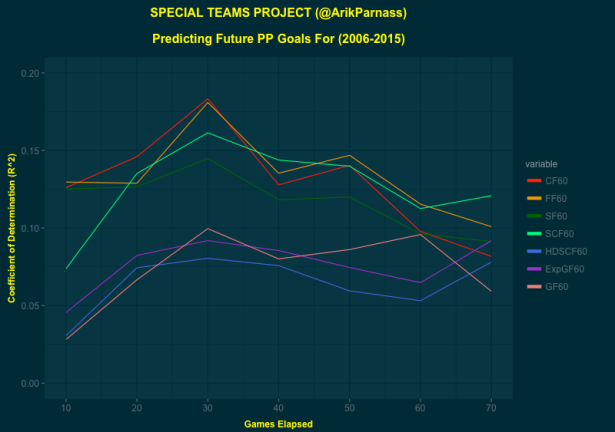Month: January 2016
Redefining Shot Quality: One Pass at a Time
Shot quality has been a topic of late on hockey twitter and various sites. Only a few weeks ago, the Hockey-Graphs Hockey Talk was centered around this topic. Shot quality is a lightning rod and much of the talking at or past one another that people often do stems from a single issue: there is no agreed-upon definition of what people mean when they say “shot quality.” Well, I like what our own Nick Mercadante had to say on the subject:
@77PGC and that’s where guys like @RK_Stimp and @Vallys_View come in with the tracking work. Give me a base repeatable skill to analyze.
— Nick Mercadante (@NMercad) January 17, 2016
Establishing a base, repeatable skill that accounts for pre-shot movement and an increased likelihood of a goal being scored are what we need to properly analyze player contributions. Quantifying passing also gives us another actionable piece of data that everyone understands and coaches can use as well. Often, the simplest metric or method is the best. And, we should able to do that now that we’ve obtained a significant set of data. This chart may look familiar, but it’s essential to understanding how important passing is to goal-scoring. This is from all tracked passing sequences from the six teams (Chicago Blackhawks, Florida Panthers, New Jersey Devils, New York Islanders, New York Rangers, and Washington Capitals) that we tracked last season.

From this point on, I want you to forget whatever it is you think of when you hear the term, “shot quality.”
Expected Goals Data Release
 Back in October 2015, @asmae_t and I first unveiled an Expected Goals model which proved to be a better predictor of team and player goalscoring performance than any other public model to date. Thanks to the feedback of the community, a few adjustments and corrections were made since then. The changes were the following:
Back in October 2015, @asmae_t and I first unveiled an Expected Goals model which proved to be a better predictor of team and player goalscoring performance than any other public model to date. Thanks to the feedback of the community, a few adjustments and corrections were made since then. The changes were the following:
- Score state was a variable that was accounted for in the model but was not explicitly mentioned in the original write-up. Recall that after accounting for all variables, including score state, it was found that a shot attempted by a trailing team still has a lower likelihood of resulting in a goal than a shot taken by a leading team.
- The shot multiplier in Part I of the original write-up was adjusted using a historical weighted average instead of in-season data. Thus, a 2016 shot multiplier for example would be based on the average of the regressed goals (rGoals) and regressed shots (rShots) of 2014 and 2015. This adjustment improved the model’s performance against score-adjusted Corsi and goals % in predicting future scoring, as seen in the graph below. We thank @Cane_Matt again for pointing out this error.

Eric Tulsky listens to shot quality

On November 21st a similar version of the above graph was published displaying that Eric Tulsky’s addition to the Carolina Hurricanes may have improved their shot differentials, but harmed their shooting percentage.
No longer though:
Hockey Graphs Podcast Episode 32 – Tangents, and Tangents, and Tangents
Rhys and Garret update you on what’s going on at Hockey-Graphs.com while also talking about some trades, elite players, shot quality, and CSS rankings.
Special Teams Analytics in the 21st Century

Despite them accounting for approximately 20 percent of NHL game time, special teams have been largely ignored when it comes to analytics. Considering the data available and its small sample size compared to even-strength, that is somewhat understandable, and there have certainly been attempts to properly quantify and assess power plays. So what do we know so far? Continue reading
Predicting Which Players Will Succeed on the Powerplay
Alexander Semin did not have a good season last year. After producing decent numbers in his first two seasons in Carolina, with 35 goals and 51 assists in 109 games, Semin struggled in 2014-2015, putting up only 19 points over 57 games and seeing his shooting percentage drop below 10% for only the second time in his 10 year career. With three years remaining on a contract paying $7MM per season, the Hurricanes decided to cut their losses, buying out the Russian winger prior to the start of the UFA period in July.
While at first glance Semin’s release seems like a reasonable response for a former top scorer who appeared to have lost the magic touch, if we look at little closer at Semin’s numbers a different story beings to emerge. Semin logged only 1.5 minutes of powerplay time per game in 2014-2015, down more than 2 minutes from his 2013-2014 total, and well below the 4+ minutes he would see at the start of his career in Washington. While other factors certainly played a role in his fall from grace (a 97.5 PDO at 5-on-5 doesn’t help), there’s no denying that the coaching staff’s decision to keep Semin off the ice when the ‘Canes were up a man cost him (and likely the team) points.
Although Semin is an extreme case, the general story of a player losing points as his powerplay time decreases is not uncommon amongst NHLers, and illustrates that opportunity often matters just as much as ability when it comes to a player’s results. Each team’s powerplay minutes are limited, and valuable to both the team and player, given the higher scoring environment that exists when a team is up a skater. Overall, teams scored roughly 25% of their goals on the powerplay last year, despite the fact that less than 20% of total ice time was played with a team on the man-advantage.
Hockey Talk: Shot Quality
Hockey Talk is a (not quite) weekly series where you will get to view the dialogue among a few Hockey-Graphs contributors on a particular subject, with some fun tangents.
This week we started from a Twitter conversation suggesting that expected goals calculations (xG) might underweight “shot quality”. A topic that HG contributors are hardly short of opinions on. Continue reading
Practical Concerns: Meatballs & The Art Of Deployment

Last week, I dug up some old stats and posed this question to our Twitter followers and to a few people I know working in pro hockey.
Some interesting lessons were learned.
Information Underload
Marc Bergevin once said that it is difficult for fans to fully understand the decision-making process of NHL general managers and coaches because they don’t have access to all the information.
Most people I’ve talked to with at least a working knowledge of analytics were able to give very sensible suggestions on which three defense pairings to form given the available players, despite having no idea of who these players are and with only their 5vs5 With or Without You possession stats at their disposal.
Hockey Graphs Podcast Episode 31b – Team USA Sux! (not actually)
We’re back after our short break… This time we promise the recording will last longer than 2 minutes!!
Rhys and Garret update you on what’s going on at Hockey-Graphs.com while also talking about the World Juniors and some trade frenzy.

